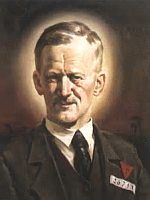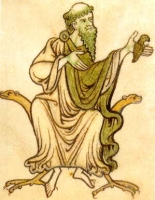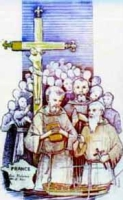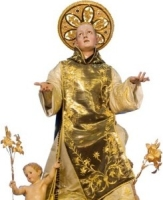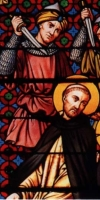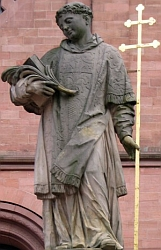St. Mary Elizabeth Hesselblad
Feastday: June 4
Patron: Bridgettines, Nun, Nursing
Birth: June 4, 1870
Death: April 24, 1957
Beatified: April 9, 2000, Saint Peter's Square, Vatican City by Pope John Paul II
Canonized: June 5, 2016, Saint Peter's Square, Vatican City by Pope Francis
The Servant of God was born in the little village of Faglavik, in the province of Alvsborg, on the 4 June 1870, the fifth of thirteen children born to Augusto Roberto Hesselblad and Cajsa Pettesdotter Dag. The following month she was baptized and received into the Reformed Church of Sweden in her parish in Hundene. Her childhood was lived out in various places, since economic difficulties forced the family to move on several occasions.
In 1886, in order to make a living and to support her family, she went to work first of all in Karlosborg and then in the United States of America. She went to nursing school at the Roosevelt hospital in New York and dedicated herself to home care of the sick. This meant that she continually had to make many sacrifices, which did not do her health any good, but certainly helped her soul to flourish. The contact she had with so many sick catholics and her thirst for truth helped to keep alive in her heart her search for the true flock of Christ. Through prayer, personal study and a deep daughterly devotion to the Mother of the Redeemer, she was decisively led to the Catholic Church and, on the 15 August 1902, in the Convent of the Visitation in Washington, she received conditional baptism from Fr. Giovani Giorgio Hagen, S.J., who also became her spiritual director. Looking back on that moment of grace, she wrote, "In an instant the love of God was poured over me. I understood that I could respond to that love only through sacrifice and a love prepared to suffer for His glory and for the Church. Without hesitation I offered Him my life, and my will to follow Him on the Way of the Cross." Two days later she was nourished by the Eucharist, and then she left for Europe.
In Rome she received the Sacrament of Confirmation and she clearly perceived that she was to dedicate herself to the unity of Christians. She also visited the church and house of Saint Bridget of Sweden (+ 1373), and came away with a deep and lasting impression: "It is in this place that I want you to serve me." She returned to the United States but, her poor health notwithstanding, she left everything and on 25 March 1904 she settled in Rome at the Casa di Santa Brigida, receiving a wonderful welcome from the Carmelite Nuns who lived there. In silence and in prayer she made great progress in her knowledge and love of Christ, fostered devotion to Saint Bridget and Saint Catherine of Sweden, and nourished a growing concern for her people and the Church. In 1906 Pope Saint Pius X allowed her to take the habit of the Order of the Most Holy Saviour of Saint Bridget and profess vows as a spiritual daughter of the Swedish saint. In the years that followed she strove to bring back to Rome the Order of the Most Holy Saviour, and to that end she visited the few existing Brigettine monasteries in Europe, an experience that brought joys, disappointments and no concrete help. Her dream of bringing to birth a Brigettine community in Rome that was made up of members coming from monasteries of ancient observance, was not realized. However Divine Providence, in ways that were quite unexpected, enabled a new branch to grow from the ancient Brigettine trunk. In fact, on the 9 November 1911, the Servant of God welcomed three young English postulants and refounded the Order of the Most Holy Saviour of Saint Bridget, whose particular mission was to pray and work, especially for the unity of Scandinavian Christians with the Catholic Church.
In 1931 she experienced the great joy of receiving the Holy See's permission to have permanent use of the church and house of Saint Bridget in Rome. These became the centre of activity for the Order which, driven on by its missionary zeal, also established foundations in India (1937). During and after the Second World War, the Servant of God performed great works of charity on behalf of the poor and those who suffered because of racial laws; she promoted a movement for peace that involved catholics and non-catholics; she multiplied her ecumenical endeavours and for many people who belonged to other religions or other christian confessions, she was part of their journey towards the Catholic Church.
From the very beginning of her Foundation she was particularly attentive to the formation of her spiritual daughters, for whom she was both a mother and a guide. She implored them to live in close union with God, to have a fervent desire to be conformed to our Divine Saviour, to possess a great love for the Church and the Roman Pontiff, and to pray constantly that there be only one flock and one shepherd, adding, "This is the prime goal of our vocation." She also devoted herself to fostering a unity of spirit within the Order. "The Lord has called us from different nations," she wrote, "but we must be united with one heart and one soul. In the divine Heart of Jesus we will always meet one another and there we seek our strength to face the difficulties of life. May we be strengthened to practice the beautiful virtues of charity, humility and patience. Then our religious life will be the antechamber to Heaven." On other occasions she said, "Our religious houses must be formed after the example of Nazareth: prayer, work, sacrifice. The human heart can aspire to nothing greater."
Throughout her life she remained faithful to what she had written in 1904: "Dear Lord, I do not ask to see the path. In darkness, in anguish and in fear, I will hang on tightly to your hand and I will close my eyes, so that you know how much trust I place in you, Spouse of my soul." Hope in God and in His providence supported her in every moment, especially in times of testing, solitude and the cross. She put the things of Heaven before the things of earth, God's will before her own, the good of her neighbour before her own benefit.
Contemplating the infinite love of the Son of God, who sacrificed Himself for our salvation, she fed the flame of love in her heart, as manifested by the goodness of her works. Repeatedly to her daughters she said, "We must nourish a great love for God and our neighbors; a strong love, an ardent love, a love that burns away imperfections, a love that gently bears an act of impatience, or a bitter word, a love that lets an inadvertence or act of neglect pass without comment, a love that lends itself readily to an act of charity." The Servant of God was like a garden in which the sun of charity brought to bloom the flowers of the spiritual and corporal works of mercy. She was filled with care and concern for her Sisters, for the poor, the sick, the persecuted Jewish people, for priests, for the children to whom she taught Christian doctrine, for her family and for the people of Sweden and Rome. She was a humble Sister and most obliging to all who sought her help. She always felt a sense of duty and great joy in sharing with others the gifts she had received from the Lord, and this she did with gentleness, graciousness and simplicity. She was prudent in her work for the Kingdom of God, in her speaking, acting, advising and correcting. She had great respect for the religious freedom of non-christians and non-catholics, whom she received gladly under her roof. She practiced justice towards God and neighbour, temperance, self-control, reserve, detachment from the honours and things of the world, humility, chastity, obedience, fortitude in tribulation, perseverance in her praise and service of God, faithfulness to her religious consecration.
She walked with God, clinging to the cross of Christ, who was her companion from the days of her youth. "For me," she said, "the way of the Cross has been the most beautiful of all because on this path I have met and known my Lord and Saviour." Unremittingly her physical suffering went hand in hand with her moral suffering. The cross became particularly heavy and painful during the final years of her life, when the Holy See prepared the Canonical Visit of her Order as her health got progressively worse. In prayer and peaceful submission to God's will she prepared herself for the final meeting with the Divine Spouse, who called her to Himself in the early hours of 24 April 1957.
The reputation for holiness which surrounded her in life increased after her death, and almost immediately the Vicariate of Rome began the cause for Beatification.
Saint Petroc
புனிதர் பெட்ராக்
மடாதிபதி:
பிறப்பு: வேல்ஸ் (Wales)
இறப்பு: கி.பி. 564
டிரரேவேல், பேட்ஸ்டோவ், கோர்ன்வால், இங்கிலாந்து
ஏற்கும் சமயம்:
ரோமன் கத்தோலிக்க திருச்சபை
ஆங்கிலிக்கன் சமூகம்
முக்கிய திருத்தலம்:
புனித பெட்ராக் தேவாலயம், போட்மின், கோர்ன்வால், இங்கிலாந்து
நினைவுத் திருநாள்: ஜூன் 4
பாதுகாவல்:
டேவோன் (Devon), கோர்ன்வால் (Cornwall)
புனிதர் பெட்ராக், ஒரு பிரிட்டிஷ் இளவரசரும், கிறிஸ்தவ புனிதரும் ஆவார். அனேகமாக தெற்கு வேல்ஸ் (South Wales) பிராந்தியத்தில் பிறந்த இவர், ஆரம்பத்தில் இங்கிலாந்தின் "டேவோன்" (Devon) மற்றும் "கோர்ன்வால்" (Cornwall) ஆகிய பகுதிகளில் மறை போதனை நிகழ்த்தினார்.
"க்ளிவிஸ்" (Glywys of Glywysing) எனும் அரசனின் மகனாகப் பிறந்த இவர், அயர்லாந்தில் (Ireland) கல்வி கற்றார். பின்னாளில், அங்கேயே புனிதர் கெவின் (Saint Kevin) என்பவருக்கு ஆசிரியராக பணியாற்றியுள்ளார்.
தம்மை ஆன்மீகத்தில் மென்மேலும் செம்மைப்படுத்தும் நோக்கமாக அவர் ரோம் நகருக்கு புனித யாத்திரை சென்றார். "கோர்ன்வால்" (Cornwall) நகருக்கு திரும்பிய இவர், தாமே நிறுவிய துறவு மடத்தில் தம்மைத்தாமே அடைத்துக்கொண்டார். "போட்மின்" (Bodmin) பகுதியில் இரண்டாவது துறவு மடத்தினை கட்டிய இவர், அங்கேயே பெரிய தேவாலயம் ஒன்றினையும் கட்டினார்.
பெட்ராக், "லிட்டில் பேதேறிக் மற்றும் போட்மின்"(Little Petherick and Bodmin) ஆகிய பகுதிகளிலும் பிரிட்டன், வேல்ஸ் மற்றும் பிரிட்டனி (Britain, Wales and Brittany) ஆகிய மாநிலங்களின் பல பகுதிகளிலும் தேவாலயங்களை கட்டினார்.
மான் வேட்டையாடிய மன்னன் "கான்ஸ்டன்டைன்" (Constantine of Cornwall) என்பவரிடமிருந்து ஒரு மானை இவர் காப்பாற்றியதனால் மன்னன் கிறிஸ்தவ மதத்திற்கு மனம் மாறியதாக கூறப்படுகிறது.
சுமார் முப்பது வருடங்களின் பின்னர் "பிரிட்டனி" (Brittany) வழியாக ரோம் நகருக்கு யாத்திரை சென்ற புனிதர் பெட்ராக், "லிட்டில் பெதேரிக்" (Little Petherick) எனும் இடத்தினருகேயுள்ள "டிரரேவேல்" (Treravel) எனுமிடத்தில் மரணம் அடைந்தார்.
Also known as
Petrock, Pedrog, Perreuse, Perreux, Petrocus, Petrox
Profile
Younger son of King Glywys. On his father's death, the people of Glywysing called for Petroc to take the crown of one the country's sub-divisions, but Petroc wanted a religious life, and went to study in Ireland.
Several years later he returned to Britain, landing on the River Camel in Cornwall. Directed by Saint Samson to the hermitage of Saint Wethnoc. Wethnoc agreed to give his cell to Petroc in order that he could found a monastery on the site.
After 30 years as abbot, Petroc made a pilgrimage to Rome, Italy. On his return, just as he reached Newton Saint Petroc, it began to rain. Petroc predicted it would soon stop, but it rained for three days. In penance for presuming to predict God's weather, Petroc returned to Rome, then to Jerusalem, then to India where he lived seven years on an island in the Indian Ocean.
Petroc returned to Britain with a wolf companion he had met in India. Founded churches at Saint Petrox and Llanbedrog. In Cornwall, with the help of Saint Wethnoc and Saint Samson, he defeated a mighty serpent that King Teudar of Penwith had used to devour his enemies. He then left his monastery at Llanwethinoc to live as a hermit in the woods at Nanceventon, some fellow monks following his example at Vallis Fontis. While in the wilderness, a hunted deer sought shelter in Saint Petroc's cell. Petroc protected it from the hunter, King Constantine of Dumnonia, and converted the king to Christianity in the bargain.
Petroc later moved deep into the Cornish countryside, encountering the hermit Saint Guron. Guron moved south allowing Petroc, with the backing of King Constantine, to establish a monastery called Bothmena (the Abode of Monks) at the site of the hermitage.
Died
• c.594 at Treravel, Padstow, Cornwall (in modern England) of natural causes while on the road
• buried at Padstow
• relics stolen in 1177 and given to the Abbey of Saint Meen
• relics later returned to the Bothmena monastery
• relics destroyed during the English Reformation
Patronage
• Bodmin, Cornwall
• Caernarfonshire, Wales
• Cornwall, England
• Devon, England
• Exeter, Devonshire, England
• Hollacombe, Devonshire, England
• Little Petherick, Cornwall
• Nansfenten, Cornwall
• Llanbedrog, Wales
• Lydford, Devonshire, England
• Newton Saint Petrock, Devonshire, England
• Padstow, Cornwall
• Saint-Méen, France
• South Brent, Devonshire, England
• Trevalga, Cornwall
• West Anstey, Devonshire, England
Blessed Stanislaw Kostka Starowieyski
Also known as
prisoner 26711
Additional Memorial
12 June as one of the 108 Martyrs of World War II
Profile
Graduated high school in 1914. Studied law at Jagiellonian University in Krakow, Poland, but his studies were interrupted by the start of World War I. Soldier and officer in the Austrian army, he fought on the eastern front and in Italy. Helped found the Polish army in 1918. Fought in the Polish-Ukrainian War of 1918-1919, defending the citadel of Lviv. Fought in the Polish-Russian war of 1920, rising to the rank of captain and receiving decorations for bravery. A near fatal bout of dysentery ended his military career in 1920.
Returning to civilian life with exceptional organization and people skills, he studied agriculture, and in 1921 took over management of the 1,000 acre Zamosc farms in Labunie, Poland; he was known for insuring his people were paid fairly, and had medical coverage. Married to Maria Theresa Szeptycka in 1921. The family went to daily Mass, and spent largely on charity, food for the poor, and Catholic social activities. Not content with checkbook-charity, he visited and helped the poor and orphans regardless of nationality or religion. He supported the Marian Congregation, Catholic Action, pilgrimages to Jasna Gora, and the study of Catholic social doctrine. Worked to create better working conditions and cooperation between farms to promote agricultural production. Vice-president of Catholic Action in 1932; president of the Diocesan Institute of Catholic Action in Lublin, Poland in 1935. He declined an offer to run for the Polish senate in 1935. Honorary papal chamberlain to Pope Pius XI.
Arrested with his brother Marian by invading Russian troops in November 1939; they escaped in Debiny Laszczowskiej, but Marian was re-captured, sent to the Russian interior, and was never heard from again. Stanislaw was captured by German troops and sent to the Nazi concentration camp at Dachau, Germany for the crime of being a Catholic leader. Martyr.
Born
11 May 1895 in Ustrobna, Podkarpackie, Poland
Died
13 April 1941 in Dachau, Oberbayern, Germany
Beatified
13 June 1999 by Pope John Paul II
Patronage
Catholic Action in Poland
Saint Filippo Smaldone
புனிதர் ஃபிலிப்போ ஸ்மால்டோன்
குரு நிறுவனர்:
பிறப்பு: ஜூலை 27, 1848
நேபிள்ஸ், இரண்டு சிசிலிகளின் இராச்சியம்
இறப்பு: ஜூன் 4, 1923 (வயது 74)
லெக்ஸ், இத்தாலி இராச்சியம்
ஏற்கும் சமயம்:
ரோமன் கத்தோலிக்க திருச்சபை
முக்திப்பேறு பட்டம்: மே 12, 1996
திருத்தந்தை இரண்டாம் ஜான் பவுல்
நியமனம்: அக்டோபர் 15, 2006
திருத்தந்தை பதினாறாம் பெனடிக்ட்
நினைவுத் திருநாள்: ஜூன் 4
பாதுகாவல்:
திருஇருதய சலேசியன் அருட்சகோதரியர்
காது கேளாத மக்கள்
வாய் பேச இயலாத மக்கள்
புனிதர் ஃபிலிப்போ ஸ்மால்டோன், ஒரு இத்தாலிய ரோமன் கத்தோலிக்க குருவும், "திருஇருதய சலேசியன் அருட்சகோதரியர்" (Salesian Sisters of the Sacred Hearts) சபையின் நிறுவனரும் ஆவார். ஸ்மால்டோன் தனது வாழ்நாளில் காது கேளாதோருடனான விரிவான பணிகளுக்காக மிகவும் பிரபலமானவர். அருட்தந்தை ஸ்மால்டோன் ஒரு திறமையான போதகராக இருந்தார். அவர் அனாதைகள் மற்றும் ஊமை மக்களை சரியான முறையில் கவனிப்பதிலும், பராமரிப்பதிலும் அர்ப்பணிப்புடன் அறியப்பட்டார். இது அவருக்கு குடிமை அங்கீகாரத்தைப் பெற்றது.
ஃபிலிப்போ ஸ்மால்டோன், கி.பி. 1848ம் ஆண்டில் நேபிள்ஸ் (Naples) நகரில் வசித்துவந்த அன்டோனியோ ஸ்மால்டோன் (Antonio Smaldone) மற்றும் மரியா கான்செட்டா டி லூகா (Maria Concetta De Luca) ஆகியோரது ஏழு குழந்தைகளில் முதல் குழந்தையாகப் பிறந்தார். அவர் கி.பி. 1858ல், தனது முதல் நற்கருணை (First Communion) பெற்ற இவர், கி.பி. 1862ம் ஆண்டு, தனது உறுதிப்பூசுதல் (Confirmation) அருட்பிரசாதத்தையும் பெற்றார்.
தமது படிப்புக்காக அப்போஸ்தலப் பணிகளை கைவிட விரும்பாத இவர், இளம் சபைக்கான தேர்வில் கிட்டத்தட்ட தோல்வியடைந்தார். நேபிள்ஸ் கார்டினல் பேராயர் (Cardinal Archbishop of Naples) வணக்கத்துக்குரிய சிஸ்டோ ரியாரியோ ஸ்ஃபோர்ஸ் (Venerable Sisto Riario Sforz) அனுமதியுடன் கி.பி. 1876ம் ஆண்டில் அவர் நேபிள்ஸுக்குத் திரும்பினார். ரோசானோ-கரியாட்டி (Archdiocese of Rossano-Cariat) மறைமாவட்டத்தில் கல்வி கற்ற காலத்திற்குப் பிறகு, அவர் கி.பி. 1870ம் ஆண்டு, ஜூலை மாதம், 31ம் தேதியன்று, ஒரு துணை திருத்தொண்டராக (Subdeacon) நியமிக்கப்பட்டார். கி.பி. 1871ம் ஆண்டு, மார்ச் மாதம், 27ம் தேதியன்று, ஒரு திருத்தொண்டராக அருட்பொழிவு செய்யப்பட்டார்.
ஸ்மால்டோன், கி.பி. 1871ம் ஆண்டு, செப்டம்பர் மாதம், 23ம் நாளன்று, குருத்துவ அருட்பொழிவு பெற்றார். தனது இறையியல் கல்வியின்போது நேபிள்ஸின் காது கேளாத மக்களுக்கு உதவுவதற்கான முயற்சிகளைத் தொடங்கினார். மேலும் நோயுற்றவர்களுடன் பணியாற்றினார். ஆனால் ஒரு கட்டத்தில் தனது ஊமையாக இருந்த மாணவர்கள் மீது விரக்தியடைந்த இவர், மனச்சோர்வடைந்தார். வெளிநாட்டு மறைப்பணிகளுக்குச் செல்வதற்காக கற்பித்தல் பணியை கைவிட அனுமதி கேட்டார். ஆனால் அவரை சமாதானப்படுத்திய அவரது ஆன்மீக இயக்குனர், அவரை அங்கேயே நிலைத்திருக்கவும், தனது வேலையைத் தொடரவும் அறிவுறுத்தினார்.
கி.பி. 1884ம் ஆண்டில், அவர் வாழ்ந்த பகுதி, காலரா நோயால் பாதிக்கப்பட்டபோது, அந்நோயால் தாக்குண்ட ஸ்மால்டோன் கிட்டத்தட்ட இறக்கும் நிலைக்குப் போய் உயிர் பிழைத்தார். மேலும், அன்னை மரியாளின் கருணையாலேயே தாம் உயிர் பிழைத்ததாக உறுதியாக நம்பினார். கி.பி. 1885ம் ஆண்டில், மார்ச் மாதம், 25ம் நாளன்று, காது கேளாதோர் மற்றும் வாய் பேச இயலாதோருக்காக "லெஸ்" (Lecce) நகரில், தந்தை லோரென்சோ அப்பிசெல்லா மற்றும் பல கன்னியாஸ்திரிகளின் உதவியுடன் ஒரு சபையை நிறுவினார். அதனை தனது பராமரிப்பில் வைத்திருந்த அவர், கி.பி. 1897ம் ஆண்டில் ரோம் (Rome) மற்றும் பாரி (Bari) இரண்டு நகரங்களிலும் தனது சபையின் பல கிளைகளைத் திறந்தார். கி.பி. 1912ம் ஆண்டு, டிசம்பர் மாதம், 18ம் தேதி, அவரது சபை, ஃபிரான்சிஸ்கன் சபையுடன் (The Order of Friars Minor) ஒருங்கிணைக்கப்பட்டது. கி.பி. 1915ம் ஆண்டு, நவம்பர் மாதம், 30ம் தேதி, திருத்தந்தை பதினைந்தாம் பெனடிக்ட் (Pope Benedict XV) அவர்களிடமிருந்து பாராட்டுக்கான ஆணையை பெற்ற இவரது சபை, கி.பி. 1925ம் ஆண்டு, ஜூன் மாதம், 21ம் தேதி, ஸ்மால்டோன் இறந்த பின்னர் திருத்தந்தை பதினோராம் பயஸ் (Pope Pius XI) அவர்களிடமிருந்து முழு அங்கீகாரத்தையும் பெற்றது.
ஸ்மால்டோன், நற்கருணை பக்தியை பரப்பும் நோக்கில், "நற்கருணை ஆராதனைக்கான குருக்களின் குழு" (Eucharistic League of Priest Adorers) மற்றும், "நற்கருணை ஆராதனைக்கான மகளிர் குழு" (Eucharistic League of Women Adorers) ஆகிய இரண்டு குழுக்களை நிறுவினார். தூய ஃபிரான்சிஸ் டி சலேஸ் மறைப்பணியாளர்களின் (Missionaries of Saint Francis de Sales) தலைமைப் பொறுப்பில் அவர் ஒரு குறுகிய காலத்திற்கு பணியாற்றினார். அவரை லெஸ் பேராலயத்தில் பொறுப்பாளராக நியமனம் செய்த திருச்சபை அதிகாரிகளைப் போலவே, குடிமை அதிகாரிகளும் அவரைப் பாராட்டி அங்கீகரித்தனர். கி.பி. 1880ம் ஆண்டில், மிலன் (Milan) நகரில் நடந்த காது கேளாதோருக்கான ஆசிரியர்களின் மாநாட்டில் ஒரு நிபுணராக பங்கேற்க அனுப்பப்பட்டார்.
நீரிழிவு தொடர்பான சிக்கல்களாலும், இருதய நோய்களாலும் பாதிக்கப்பட்டிருந்த ஸ்மால்டோன், கி.பி. 1923ம் ஆண்டு, ஜூன் மாதம், 4ம் தேதி, இரவு 9:00 மணிக்கு இறந்தார். அவரது மீபொருட்கள், பின்னர் 1942ம் ஆண்டு, சபையின் தலைமை இல்லத்திற்கு மாற்றப்பட்டன. 2005ம் ஆண்டில், இவரது சபையின் கிளைகள், ருவாண்டா (Rwanda), மால்டோவா (Moldova) போன்ற நாடுகளில் 398 மறைப்பணியாளர்களுடன், மொத்தம் 40 இல்லங்கள் இருந்தன.
Profile
While in seminary, Filippo worked extensively with deaf-mutes in Naples, Italy. Ordained in 1871. While working with plague victims, he contracted the disease himself, but was miraculously cured through the intervention of Our Lady of Pompei. At one point, depressed over the frustration of his mute students, he asked to give up his teaching, and to work in the foreign missions; his spiritual advisor convinced him to stay, and Filippo threw himself into the work. In March 1885, with the help of Father Lorenzo Apicelia and several nuns he had trained, he founded a school for deaf-mutes in Lecce, Italy; it became the mother-house of the Congregation of the Salesian Sisters of the Sacred Hearts. Father Filippo soon expanded the work of his schools to include blind, orphaned, or abandoned children. Served as confessor and spiritual director to priests, seminarians, and several religious communities. Founded the Eucharistic League of Priest Adorers and Eucharistic League of Women Adorers. Superior of the Congregation of the Missionaries of Saint Francis de Sales. Canon of the Lecce cathedral. Recognized and commended by civil authorities for his good works.
Born
27 July 1848 in Naples, Italy
Died
4 June 1923 in Lecce, Italy from a combination of diabetes and a heart condition
Canonized
15 October 2006 by Pope Benedict XVI
Saint Francis Caracciolo
புனித பிரான்ஸ் கராசியோலா
பிறப்பு : 13 அக்டோபர் 1563
வில்லா சாந்தா மரியா (Santa Maria), நேப்பிள்ஸ் பேரரசு
இறப்பு : 4 ஜூன் 1608 ( அகவை 44 )
நேயாப்பல் (Neapel)
அருளாளர் பட்டம் : ஜூன் 4, 1769
திருத்தந்தை பதினான்காம் கிளேமன்ட்
புனிதர் பட்டம் : மே 24, 1807
திருத்தந்தை ஏழாம் பயஸ்
நினைவுத் திருநாள் : ஜுன் 4
பாதுகாவல் :
நேப்பிள்ஸ் (இத்தாலி) ,இத்தாலிய சமையல்காரர்கள்
புனித பிரான்ஸ் கராசியோலா, பிறந்த சில நாட்களிலேயே தோல் நோய்க்கு ஆளானார். இதனால் பலமுறை மக்களால் ஒதுக்கப்பட்டார். இவர் புரிந்த கடுந்தவத்தினாலும், ஜெபத்தினாலும் இவரது நோய் குணமாகியது. நோயாளிகளை பராமரிக்கும் பணியை இவர் சிறுவயதிலேயே மிக ஆர்வத்தோடு செய்துவந்தார்.
அப்போது பணியாற்றும் போது ஒருநாள், தான் ஓர் குருவாக வேண்டுமென்ற எண்ணம் மனதிற்குள் உதிக்கவே 1587ம் தன் ஆசையை நிறைவேற்றி குருவானார். குருவான பிறகும் தொடர்ந்து நோயாளிகளை கவனிக்கும் பொறுப்பும், இறக்கும் தருவாயில் உள்ளவர்களை, அமைதியான மரணமடைய தயாரிக்கும் பொறுப்பும், இவருக்கு அளிக்கப்படவே, அப்பணியை இவர் மிகுந்த ஆர்வத்துடனும், புனிதத்துடனும் செய்தார். அதோடு மனநோயாளிகளையும் கவனித்து ஆறுதல் அளித்து வந்தார்.
இவரது பணி மிகவும் வளர்ச்சியடையவே நோயாளிகளின் எண்ணிக்கை அதிகரித்து பெரிய குழுவாக காட்சியளித்தது. எனவே அவர்களைக் கொண்டு ஏழைகளை பராமரிப்பதற்கென ஒரு சபையைத் தொடங்கினார். 1588ம் ஆண்டு அச்சபை துறவற சபையாக, திருத்தந்தை 5ம் சிக்ஸ்டஸ் (Pope Sixtus V) அவர்களால் அங்கீகரிக்கப்பட்டது.
அச்சபையை தொடர்ந்து, மிகப் பொறுப்போடு கவனிக்க ஜியோவானி அடோர்னோ (Giovanni Adorno) என்பவரை சபைத்தலைவராக தேர்ந்தெடுத்தார். 1593ம் ஆண்டு வரை அவர் பணியாற்றி இறந்துவிடவே, பிரான்ஸ் கராசியோலா சபைத்தலைவர் பொறுப்பை ஏற்றார். பின்னர் அவர் அச்சபைக்கு "ஏழைகளின் நண்பர்" என்று பெயரிட்டார்.
மிக விரைவாக அச்சபை ஸ்பெயின் மற்றும் மற்ற ஐரோப்பிய நாடுகளில் பரவியது. இவர் தனது துறவற குழுமங்களை பார்வையிட அடிக்கடி ஏராளமான பயணங்களை மேற்கொண்டார். இதனால் மீண்டும் நோய்தாக்கப்பட்டு தன் 44ம் வயதில் இறந்தார்.
Also known as
• Ascanio Pisquizio
• Francesco Caracciolo
Profile
Born to the nobility; related to Saint Thomas Aquinas and to the princes of Naples. Enjoyed hunting. Cured of a leprous-like disease at age 22, he took the cure as a miraculous sign for his life. He sold his goods, gave the money to the poor, and went to study theology in Naples, Italy in 1585. Ordained in 1587. Joined the Contraternity of the Bianchi della Giustizia (the White Robes of Justice) whose ministry was with condemned prisoners. With John Augustine Adorno, he founded the Congregation of the Minor Clerks Regular with a ministry to the sick and to prisoners; they received approval from Pope Sixtus V on 1 July 1588, Pope Gregory XIV on 18 February 1591, and Pope Clement VIII on 1 June 1592. Chosen superior of the Congregation at Naples on 9 March 1593; he made sure to daily perform the most menial tasks of the house. Established Congregation houses in Rome, Madrid, Valladolid, and Alcala. Noted for his work for the poor, and as a miracle worker and prophet; he was a popular preacher, and cured by blessing the sick with the sign of the cross. Pope Paul V wished to make him a bishop, but he repeatedly refused, citing the Congregation's vow not to seek any high position in the Church. Near the end of his life he resigned his duties and spent his remaining time as prayerful prior and novice master at Santa Maria Maggiore.
Born
13 October 1563 at his family's castle at Villa Santa Maria, Abruzzi, Italy as Ascanio Pisquizio
Died
• 4 June 1608 at Agnone, Italy of a fever
• relics at Naples, Italy and San Lorenzo in Lucina, Rome, Italy
Beatified
4 June 1769 by Pope Clement XIV
Canonized
24 May 1807 by Pope Pius VII
Patronage
• Association of Italian Cooks (chosen in 1996)
• Naples, Italy (chosen in 1838)
Blessed Antoni Zawistowski
Additional Memorial
12 June as one of the 108 Martyrs of World War II
Profile
After high school, Antoni studied at the Metropolitan Seminary in Lublin, Poland, and the Theological Academy in Saint Petersburg, Russia. Ordained a priest for the archdiocese of Lublin in 1906. Father Antoni returned to Lublin where he served as vicar of the cathedral parish, professor of theology at the Lublin seminary, and vice-rector of the school from 1918 to 1929. Away from the school and church, he was active in local charities and became known in the city as the almoner for the money he raised for the poor.
On 17 November 1939, about 10 weeks into the German invasion of Poland, Father Antoni, along with other clergy in the diocese, was arrested by the Gestapo and imprisoned in Lublin Castle. On trumped up charges, stemming from being a loyal and active priest, Antoni was first sentenced to death, which was then commuted to life imprisonment. On 4 December 1939 he was transferred to the Sachsenhausen concentration camp, and then on 14 December 1940 he was transferred to the Dachau concentration camp. Over his remaining 18 months, between forced labour and torture sessions, Father Antoni ministered to other prisoners. Martyr.
Born
10 November 1882 in Strumiany, Wielkopolskie, Poland
Died
• 4 June 1942 in the Dachau concentration camp, Oberbayern, Germany of overwork, abuse and neglect
• his body was destroyed in the camp crematorium
Beatified
13 June 1999 by Pope John Paul II
Patronage
Metropolitan Seminary in Lublin, Poland
Saint Pacificus of Cerano
Also known as
• Pacifico Ramati
• Pacificus of Ceredano
• Pacificus Ramota
Profile
Pacificus was orphaned very young. Educated at the Benedictine monastery in Novara, Italy. Joined the Friars Minor in 1445. Received a doctorate from the Sorbonne in Paris, France, and was considered one of the most learned men of his day. Ordained in 1452. Preached missions throughout Italy from 1452 through 1471. Sent by Pope Sixtus IV to Sardinia as an evangelist and reformer. Founded a monastery in Vigevano, Italy and used it as a base for his teaching and preaching. In 1480 he was sent to Sardinia to preach the Franciscan Crusade to Turkey.
Born
c.1424 at Cerano, Novara, Lombardy, Italy
Died
• 14 June 1482 in Sassari, Sardinia, Italy of natural causes
• relics at Cerano, Italy
Beatified
7 July 1745 by Pope Benedict XIV (cultus confirmed)
Patronage
Cerano, Italy
Blessed Francesco Pianzola
Also known as
• Francis Pianzola
• Apostle of Lomellina
Profile
Born to a farming family. Studied at the seminary of Vigevano, Italy, and was ordained on 16 March 1907. He became an itinerant preacher, ministering to the poor, to children at their homes, to farm workers in the fields, to young women in the factories. Founded the Suore Missionarie dell'Immacolata, Regina della Pace (Missionary Sisters of the Immaculate, Queen of Peace) based in Mortara, Italy; the Sisters continued the work of taking Christ to the poor, the humble, the workers.
Born
5 October 1881 in Sartirana Lomellina, Pavia, Italy
Died
• 4 June 1943 at the General House of the Sisters in Mortara, Pavia, Italy of natural causes
• interred at the General House of the Sisters
Beatified
• 4 October 2008 by Pope Benedict XVI
• beatification recognition celebrated at the cathedral in Vigevano, Italy by Cardinal Jose Saraiva Martins
Saint Optatus of Milevis
Also known as
Optate, Ottato
Profile
Raised a pagan. Rhetorician. Convert to Christianity. Lived through the persecutions of Diocletian and Julian the Apostate. Late fourth century bishop of Milevis, Numidia (modern Algeria). Wrote against the Donatists.
Died
interred in the cemetery of Saint Callistus, Rome, Italy
Blessed José María Gran Cirera
Profile
A member of the Missionaries of the Sacred Heart, making his profession on 8 September 1969. Ordained a priest in Valladolid, Spain on 9 June 1972. In 1975 he was sent to minister in Guatemala where he worked with the poorest people until murdered by the military. Martyr.
Born
27 April 1945 in Barcelona, Spain
Died
shot on 4 June 1980 in Xeixojbitz, Quiché, Guatemala
Beatified
• 23 April 2021 by Pope Francis
• beatification recognition celebrated in Santa Cruz del Quiché, Guatemala
Saint Quirinus of Sescia
புனிதர் குயிரினஸ்
ஆயர், மறைசாட்சி:
பிறப்பு: தெரியவில்லை
இறப்பு: கி.பி. 309
சபரியா, பன்னோனியா, ரோம பேரரசு
ஏற்கும் சமயம்:
ரோமன் கத்தோலிக்க திருச்சபை
முக்கிய திருத்தலம்:
சேன் செபஸ்டினோ பேராலயம், ஃபுயோரி லெ முரா, ரோம், இத்தாலி
நினைவுத் திருநாள்: ஜூன் 4
பாதுகாவல்:
சிசக், குரோஷியா
புனிதர் குயிரினஸ், குரோஷியா (Croatia) நாட்டின் "சேசியா" (Sescia) மறைமாவட்டத்தின் ஆதிகால ஆயர் ஆவார். இது, தற்போதைய "சிசக்" (Sisak) மறைமாவட்டம் ஆகும். இவர், "செசரியாவின் யூசிபியஸ்" (Eusebius of Caesarea) மூலமாக குறிப்பிடப்படுகிறார்.
இவர், கி.பி. 309ம் ஆண்டு, "டயக்லேஷியன்" துன்புருத்தல்களின்போது (Persecutions of Diocletian) கொல்லப்பட்டதாக ஒரு நம்ப இயலாத குறிப்பும் உள்ளது. தப்பி ஓட முயன்ற குயிரினஸ், கைது செய்யப்பட்டு சிறையிலடைக்கப்பட்டார். சிறையில், தமது சிறை அதிகாரியான "மார்செல்லஸ்" (Marcellus) என்பவனை கிறிஸ்தவ மதத்திற்கு மனம் மாற்றினார்.
மூன்று நாட்களின் பின்னர், "பன்னோனியா பிறிம்" மாநில ஆளுநரான (The Governor of Pannonia Prim) "அமன்ஷியஸ்" (Amantius) என்பவன் "சபரியா" (Sabaria) என்ற இடத்திற்கு கொண்டுசெல்ல உத்தரவிட்டான். இந்த இடம் தற்போது ஹங்கேரி நாட்டிலுள்ள "ச்ஸோம்பதெளி" (Present-day Szombathely, Hungary) ஆகும். அங்கே அவருடைய விசுவாசத்தைக் கெடுக்கும் முயற்சிகள் நடந்தன. பின்னர், ஆயரது கழுத்தில் ஒரு மைல்கல்லை கட்டி, உள்ளூரிலுள்ள "ஜியோன்ஜியோஸ்" (Gyöngyös River) ஆற்றில் எறிந்தனர்.
உள்ளூரான "சவரியாவின்" (Savaria) கிறிஸ்தவர்கள் அவரது உடலை மீட்டு "ஸ்காரபடியஸ்" (Scarabateus) என அறியப்படும் வாயிற்கதவருகே அடக்கம் செய்தனர்
Also known as
• Quirinus of Siscia
• Kvirin, Quirino
Profile
Bishop of Sescia (modern Sisak), Croatia. During the persecution of Galerius, he was ordered to sacrifice to pagan gods; he declined. Imprisoned, severely beaten, and martyred. While in prison he converted his jailer, Marcellus.
Died
drowned in the River Raab with a millstone around his neck c.308
Patronage
• against evil spirits
• obsession
• possessed people
• Sisak, Croatia
Blessed Francis Ronci
Also known as
Francesco
Profile
Member of the Holy Spirit Community of Maiella (Celestines). Spiritual student of Saint Peter Celestine. Priest. Assisted Saint Peter at the hermitages of Orfente and Morrone. Prior of the Celestine monastery of the Holy Spirit in Maiella, Italy in 1285. First general of the Celestines, a post he held until his death. Created cardinal–priest of San Lorenzo in Damaso by Pope Celestine V on 18 September 1294.
Born
1223 in Abri, Italy
Died
13 October 1294 in Sulmona, Italy of natural causes
Blessed Domingo del Barrio Batz
Profile
Married layman of the diocese of Quiché, Guatemala. Worked as a sacristan for Blessed José María Gran Cirera in the parish of San Gaspar di Chajul, and was murdered with him. Martyr.
Born
26 January 1951 in Ilom, Quiché, Guatemala
Died
shot on 4 June 1980 in Xeixojbitz, Quiché, Guatemala
Beatified
• 23 April 2021 by Pope Francis
• beatification recognition celebrated in Santa Cruz del Quiché, Guatemala
Saint Metrophanes of Byzantium
Profile
Son of Dometius, a convert, priest and bishop of Constantinople around the fourth century; nephew of Emperor Probus. Bishop of Constantinople following his father and older brother in the position. Metrophanes' reputation for profound holiness and virtue is believed to have convinced Emperor Constantine the Great to make Constantinople the capital of the Empire.
Died
325 of natural causes
Saint Buriana of Cornwall
Also known as
Burian, Buryan
Profile
Sixth-century anchoress in Cornwall. The town of Saint Buryan, whose parish church served as her base, is named after her. May have been the daughter of an Irish king, and some writers says she travelled to Cornwall as a missionary to Cornish. One legend tells how she cured the paralysed son of King Geraint of Dumnonia, a miracle that brought many locals to the faith.
Born
Ireland
Blessed Margaret of Vau-le-Duc
Also known as
Margarita, Margherita, Marguerite
Profile
Daughter of Duke Henry II of Brabant. Cistercian nun. Abbess at Vau-le-Duc, Brabant (in modern Belgium), an abbey founded by her father.
Died
1277 of natural causes
Beatified
considered beata by her order from the time of her death
Saint Cornelius McConchailleach
Also known as
Cornelius Mac Conchailleadh
Profile
Joined the Augustinians at Armagh, Ireland in 1140. Abbot in 1151. Archbishop of Armagh in 1174. Pilgrim to Rome, Italy; died on his way home.
Born
Ireland
Died
1176 in Canbery, Savoy, France of natural causes
Saint Aldegrin of Baume
Also known as
Adalgrim, Adalgrin, Adegrin, Aldegrim
Profile
After a life as a knight, Aldegrin felt a call to religious life, and became a Benedictine monk at Baume Abbey. Spiritual student of Saint Odo of Cluny. Spent his latter years of his life as a hermit near Baume.
Died
939 of natural causes
Saint Walter of Fontenelle
Profile
Benedictine monk and then abbot of the monastery at Fontenelle, France, a noted spiritual center. Recognized by Pope Innocent II for this holiness and zeal to spread the Faith.
Born
England
Died
1150 of natural causes
Saint Walter of Serviliano
Profile
Benedictine hermit. Abbot. Founded the monastery of Serviliano in the Marches of Ancona, Italy, and served as its first abbot. The house became a leader in the resurgence of the Faith during that period.
Died
1250 of natural causes
Saint Nennoc
Also known as
Gwengustle, Nennoca, Nennocha, Nenoc, Nenooc, Ninnoc, Ninnocha
Profile
Daughter of Saint Brychan of Brycheiniog. Nun who followed Saint Germanus of Auxerre to France. Abbess of one or more convents in Brittany.
Born
Britain
Died
c.467 of natural causes
Saint Breaca of Cornwall
Also known as
Branca, Banka, Breague
Profile
Spiritual student of Saint Brigid of Ireland. Missionary to Cornwall, England c.460. Worked with Saint Crewanna and Saint Elwin.
Born
5th-century in East Meath, Ireland
Saint Cyrinus of Aquileia
Also known as
Cirino
Profile
One of a group of approximately 200 Christians martyred together. His is the only name that has come down to us, and we have no further details about him.
Died
Aquileia, Italy
Saint Saturnina of Arras
Also known as
Saturnine
Profile
Virgin-martyr.
Born
German
Died
near Arras, France, date unknown
Saint Edfrith of Lindisfarne
Also known as
Edfrid, Eadfrith
Profile
Bishop of Lindisfarne, England. He illuminated the Lindisfarne Gospels in honour of Saint Cuthbert.
Died
721
Saint Ernin of Cluain
Also known as
Ernineus
Profile
Son of Craskin. Though he is mentioned in several martyrologies, menologies and writings, no details about him have survived.
Died
634
Saint Alonio
Also known as
Alonium, Halonium
Profile
Hermit in the Egyptian desert noted by other monks, abbots and hermits for his wisdom and clear thinking.
Born
late 4th century
Died
5th century
Saint Aretius of Rome
Also known as
Arecius, Aregius
Profile
Martyr.
Died
• Rome, Italy, date unknown
• buried in the catacombs on the Appian Way
Saint Rutilus of Sabaria
Profile
One of a group of martyrs, and the only one whose name has come down to us.
Died
martyred in Sabaria, Pannonia (in modern Hungary)
Blessed Menda Isategui
Profile
Mercedarian nun at the monastery of Santa Maria della Pieta in Marquina, Spain for 80 years. Had the gift of healing by prayer, and of inedia.
Blessed Boniface of Villers
Profile
Cistercian monk. Prior of the abbey in Villers, Belgium.
Died
c.1280 of natural causes
Saint Nicolo of Sardinia
Profile
Hermit.
Saint Dacian of Rome
Profile
Martyr.
Died
• Rome, Italy, date unknown
• buried in the catacombs on the Appian Way
Saint Trano of Sardinia
Profile
Hermit.
Saint Quirinus of Tivoli
Profile
Martyr. No reliable information has survived.
Died
Tivoli, Italy, date unknown
Saint Clateus of Brescia
Profile
Bishop of Brescia, Italy. Martyred in the persecutions of Nero.
Died
64
Saint Elsiar of Lavedan
Profile
Monk at Saint-Savin, Lavedan, France.
Died
c.1050 of natural causes
Saint Christa of Sicily
Profile
Martyr.
Died
Sicily, Italy, date unknown
Saint Alexander of Verona
Profile
Eighth century bishop of Verona, Italy.
Saint Degan
Also known as
Dagan
Profile
Sixth century spiritual student of Saint Petroc in Cornwall.
Saint Croidan
Profile
Sixth century spiritual student of Saint Petroc in Cornwall.
Saint Medan
Profile
Sixth century spiritual student of Saint Petroc in Cornwall.
Martyrs of Cilicia
Profile
A group of 13 Christians who were martyred together. The only details about them that have survived are their names –
• Cama
• Christa
• Crescentia
• Eiagonus
• Expergentus
• Fortunus
• Italius
• Jucundian
• Julia
• Momna
• Philip
• Rustulus
• Saturnin
Died
in Cilicia, Asia Minor (in modern Turkey), date unknown
Martyrs of Nyon
Profile
A group of 41 Christians martyred together for refusing to sacrifice to imperial Roman idols. We know the names of some, but no other details.
• Amatus
• Attalus
• Camasus
• Cirinus
• Dinocus
• Ebustus
• Euticus
• Eutychius
• Fortunius
• Galdunus
• Julia
• Quirinus
• Rusticus
• Saturnina
• Saturninus
• Silvius
• Uinnita
• Zoticus
Died
beheaded in Noviodunum (modern Nyon, Switzerland)
Also celebrated but no entry yet
• Mary the Planter



